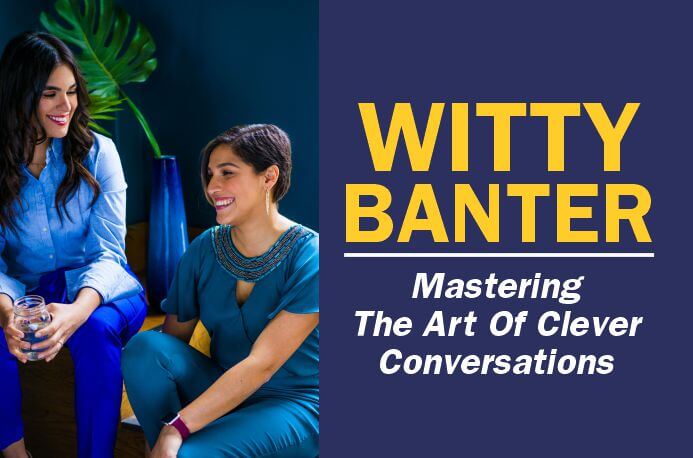Last updated on November 21st, 2023 at 10:36 am
Learn witty banter, a social intelligence tool and lubricant that helps break the ice, lighten the mood, build rapport, and sustain hearty conversations.
In my budding years, when I encounter someone who’s good at employing wits in their conversation, I am drawn to them.
I envied witty people and wished to be like them, but never knew my dad was a secret witty banterer.
An introverted personality who didn’t talk much surprised me any time he was in a light mood, especially with people he was comfortable with.
He had an unusual wit that came naturally and you can’t but want to be as spontaneous and humorous at the same time.
Well, I picked it up and honed it.
The purpose of this article is to explain to you what witty banter is, its benefits in conversations, and how you can deplore it naturally for memorable and hearty conversations.
Table of Contents
- What is Banter?
- Witty Banter Meaning
- Types of Witty Banter
- Witty Banter Examples
- How to Distinguish Witty Banter from Regular Conversation
- Benefits of Witty Banter
- How to Develop Witty Banter
- Techniques for Engaging in Witty Banter
- Common Mistakes to Avoid when Witty Bantering
- Frequently Asked Questions
- Final Thought
What is Banter?

Banter is a playful and often teasing exchange of comments, jokes, or remarks between people who are having a casual conversation.
It is a lighthearted form of communication that often involves witty or humorous remarks, and is usually done in a friendly and good-natured way.
Banter is often used as a way to build camaraderie, establish rapport, or break the ice in social situations.
While it may involve teasing or making fun of others, it is typically done in a way that is not intended to be hurtful or malicious and is instead meant to be taken as a form of friendly teasing.
Types of Banter
There are several types of banter that can be used in different situations. Here are a few examples:
- Witty banter
- Flirting banter
- Sarcasm
- Teasing banter
- Self-deprecating banter, and
- Intellectual banter
Generally, banter is a form of communication that can take many different forms, depending on the situation and the individuals involved as described above.
However, we are going to be interested in witty banter and everything surrounding it in this article.
Related: Resolving Conflicts Through Social Awareness
Witty Banter Meaning
What is Witty Banter?
It is a type of conversation characterized by clever, humorous, and often playful exchanges between individuals.
It involves using humour, wordplay, irony, sarcasm, and cultural references to engage in a lively, entertaining, and often intellectually stimulating conversation.
In essence, it is a form of communication that is aimed at entertaining and engaging others, and it can be a powerful tool in social situations, such as networking events, social gatherings, or even romantic encounters.
Related: Overcoming Social Awkwardness
To engage in this art, you must be socially aware, have a quick wit, a good sense of humour, and the ability to think on your feet.
It requires being able to read social cues, understand the nuances of language, and respond quickly and creatively to others’ comments.
Generally, being witty in conversations is a valuable social skill that can help to enhance your communication, creativity, and problem-solving abilities, and it is an important element of social interaction that should be cultivated and developed.
Types of Witty Banter

Being witty can take many forms, but here are a few common types:
1. Wordplay
Wordplay is a form of witty banter that involves clever manipulation of language, such as puns, double entendres, and other forms of verbal humor.
It often requires a quick wit and a facility with language, as the best wordplay is often spontaneous and requires a keen sense of timing and wordplay.
Wordplay Banter Example
A classic pun involves the use of words with multiple meanings or words that sound similar but have different meanings.
A common example is the pun “I’m reading a book on anti-gravity. It’s impossible to put down.” Here, the word “put down” has two meanings: to stop reading or to physically set something down.
Wordplay and witty bantering are enjoyable ways to showcase creativity and intelligence. They can break the ice in social situations and add humor to serious conversations, making interactions more engaging and lighthearted.
Related: Life Starts Where Your Comfort Zone Ends
2. Sarcasm
Sarcasm is another type that relies on the use of irony and mocking humor to convey a message.
It is often used in a playful or humorous way to point out the absurdity or hypocrisy of a situation or statement.
Sarcasm involves saying the opposite of what you really mean or saying something that is blatantly untrue but is intended to be understood as such by the listener.
It can be delivered with a dry or deadpan tone, or with exaggerated emphasis on certain words or phrases to make the irony or absurdity of the statement more apparent.
The use of sarcasm requires a certain level of wit and intelligence, as it relies on the ability to quickly recognize and play with language and social norms.
Also Read: Fake It Till You Make It: The Pros and Cons
3. Quick Comebacks
Quick comebacks are also types of witty banter characterized by a clever and often humorous response to a comment or situation.
This involves responding quickly and cleverly to a comment or insult in a twist on words or an unexpected rejoinder.
They are typically delivered in a fast and sharp manner, often catching the other person off guard and eliciting a laugh or a smile.
Quick comebacks require a sharp wit, a good sense of humor, and the ability to think on one’s feet.
They can be used in a variety of contexts, from casual social interactions to professional settings.
The key to a good quick comeback is to be clever and humorous without being offensive or hurtful to others.
Also Read: The Pitfalls Of An Abrasive Personality
4. Pop Culture References

Pop culture references can certainly be a type of witty banter, especially when used cleverly and in the right context.
This involves using references to movies, TV shows, music, or other forms of pop culture to make a witty comment.
It often involves referencing a well-known scene or line from a movie or TV show to make a point or to be funny.
Pop Culture Reference Example
For example, if someone is talking about a difficult task they have to complete, a witty response could be,
“Sounds like you’re about to climb Mount Everest!”
Referencing the well-known and challenging mountain climb. This not only shows a quick wit but also creates a fun reference to a widely known cultural phenomenon.
Related: Why You Cringe When Others Embarrass Themselves
5. Observational Humor
Observational humor is a type of witty banter that involves making humorous observations about everyday situations or human behavior.
It is a form of humor that relies on keen observation skills and the ability to see the humorous side of things that others might overlook.
In observational humor, the speaker makes humorous comments or jokes based on what they see or experience in their environment.
This type of humor is often used in stand-up comedy routines, but it can also be used in everyday conversation to lighten the mood and make people laugh.
Observational Humour Example
Some examples of observational humor might include making fun of the quirks of modern technology, poking fun at the idiosyncrasies of people in a particular profession, or commenting on the absurdities of everyday life.
6. Witty Banter Flirting
Flirting banter is a playful and lighthearted exchange of remarks or comments between two individuals with romantic interest in each other.
It is a form of communication used to create attraction, gauge compatibility, and build rapport.
Flirting banter can be seen as a test of wit, charm, and intelligence, where both parties try to impress each other through teasing and humorous remarks.
The art of flirting banter involves a delicate balance between being playful and respectful.
It is important to understand that banter should never be offensive or hurtful.
The goal is to create a fun and engaging exchange that leaves both parties feeling positive, attracted, and interested in one another.
Witty Banter Flirting Examples
Teasing and Playful Remarks
Person A: “You must be tired because you’ve been running through my mind all day!”
Person B: “Well, it’s a good thing I have comfortable shoes then!”
Light-hearted Challenges
Person A: “I bet I can beat you in a race!”
Person B: “Oh, really? You won’t even see me in your rearview mirror!”
Compliments with a Twist
Person A: “You have an incredible smile.”
Person B: “Thanks! It’s my secret weapon to brighten up any room.”
7. Quips
Quips are short and clever remarks or comments that are often humorous and sometimes sarcastic.
They are quick-witted and usually made in response to a particular situation or conversation.
Quips are often used to lighten the mood, break the tension, or make a point in a lighthearted way.
They can be spontaneous or pre-planned, and they often rely on wordplay, double entendres, or unexpected twists to be effective.
Quips Example
Some examples of quips include “I’m not arguing, I’m just explaining why I’m right,” or “I’m not lazy, I’m just conserving my energy.”
Also Read: The Science Of Mind Management
Witty Banter Examples
For a good understanding of how witty banter is used, here are example contexts from books and TV shows:
1. Example from “Pride and Prejudice” by Jane Austen:
Mr. Darcy: “Miss Elizabeth. I have struggled in vain and I can bear it no longer.
These past few months have been a torment. I came to Rosings with the single object of seeing you… I had to see you.
I have fought against my better judgment, my family’s expectations, and the inferiority of your birth by rank and circumstance. All these things I am willing to put aside and ask you to end my agony.”
Elizabeth Bennet: “I don’t understand.”
Mr. Darcy: “I love you. Most ardently.”
Elizabeth Bennet: “Well, if that is the case, then your ardor has been misplaced. I do not return it. My feelings, in every respect, forbid it” (Jane Austin).
In this exchange, Mr. Darcy expresses his love for Elizabeth in a very serious and heartfelt manner, but Elizabeth responds with a witty and humorous comment that turns the tables on him and catches him off guard.
Also Read: The Proactive Way To Regulate Your Emotions
2. Example from “The Office” TV show:
Michael Scott: “I declare bankruptcy!”
Oscar Martinez: “Hey, I just wanted you to know that you can’t just say the word bankruptcy and expect anything to happen.”
Michael Scott: “I didn’t say it. I declared it” (Office TV Show).
In this exchange, Michael Scott tries to declare bankruptcy, but Oscar humorously points out that it’s not as simple as just saying the word “bankruptcy.” Michael responds with a witty and clever retort, demonstrating his quick wit and sense of humor.
3. Example from “Friends” TV show:
Chandler Bing: “All right, kids, I gotta get to work. If I don’t input those numbers… it doesn’t make much of a difference” (Friends TV Show).
In this exchange, Chandler makes a witty and ironic comment about the importance of his job, which is actually quite mundane and unimportant.
This type of humor relies on using unexpected or ironic statements to make people laugh.
Witty banter involves using clever, humorous, and often playful language to engage in a lively and entertaining conversation.
It often involves quick wit, a good sense of humour, and the ability to think on one’s feet, and it can be a powerful tool for building rapport, breaking the ice, and entertaining others.
Related: Understanding Social Cues and Applications
How to Distinguish Witty Banter from Regular Conversation

Distinguishing witty banter from regular conversation is not challenging. Bantering involves a more playful and lighthearted tone, quick thinking and clever responses, intellectual stimulation, back-and-forth exchanges, and a focus on entertainment value.
Regular conversation may lack some of these elements and be more straightforward and practical in nature.
Here are a few key differences to look out for:
| Witty Banter | Regular Conversation |
|---|---|
| Witty banter usually has a more playful and lighthearted tone. It often involves humor, wordplay, and other forms of playfulness. | Regular conversation is more straightforward and serious. It does not incorporate playfulness, even if does, it is not regular. |
| Regular conversation is more focused on conveying information or expressing opinions. | Regular conversation may involve more thought-out and deliberate responses that might not follow any pattern and not humorous. |
| It can often be intellectually stimulating, involving references to literature, history, pop culture, and other topics. | The regular conversation may be more focused on practical or mundane matters. |
| It typically involves a back-and-forth exchange of clever remarks between two or more people. | Regular conversation may be more one-sided or focused on a single topic. |
| It is often used to entertain others and make them laugh or smile. | The regular conversation is more focused on conveying information or expressing opinions. |
Benefits of Witty Banter

I have never seen someone who is not entertained by this conversation skill. It can be a valuable tool for socializing, improving social skills, boosting confidence, encouraging creativity, providing entertainment, and fostering positive relationships.
It can be a fun and effective way to engage with others and build connections.
Here are the foremost benefits:
| Advantages of Witty Banter |
|---|
| Building Rapport: It can help build rapport between individuals by breaking down barriers and creating a shared sense of humour. It can also help people feel more comfortable and relaxed in each other’s company. |
| Enhancing Social Skills: Engaging in this art requires social skills such as active listening, quick thinking, and the ability to read social cues. Practicing these skills through witty banter can help individuals improve their overall social skills. |
| Boosting Confidence: It can boost an individual’s confidence and self-esteem, as it requires quick thinking and a certain level of social acumen. |
| Encouraging Creativity: It involves using language in creative ways, which can stimulate the mind and encourage individuals to think outside the box. |
| Providing Entertainment: It can be highly entertaining, both for those engaging in it and for those observing it. It can create a fun and lively atmosphere and provide a welcome break from more serious conversations. |
| Encourages Positive Relationships: It can create positive relationships between individuals by building a sense of camaraderie and shared experience. |
| Increases Social Connection: It can increase social connection by creating a shared sense of humor, demonstrating active listening skills, encouraging playfulness, creating shared experiences, and eliciting positive emotions. |
| Improves Communication Skills: Engaging in it can improve communication skills by fostering quick thinking, creativity, active listening, humor, confidence, and adaptability. |
How to Develop Witty Banter

Developing this skill takes time and practice. By exposing yourself to witty content, developing emotional intelligence, expanding your vocabulary, practicing active listening, experimenting with wordplay, embracing a playful attitude, and practicing regularly, you can improve your skills and become more adept at using humor and language in a clever and creative way.
Developing this skill can take time and practice, but here are some tips to get started:
Read and Watch Witty Content in Action: Expose yourself to witty content such as books, movies, and TV shows that feature characters with sharp wit and humor. This can help you develop a sense of humor and an appreciation for the nuances of language.
Expand your Vocabulary: Developing a wide range of vocabulary can help you express yourself in more creative and interesting ways. Make a habit of learning new words and incorporating them into your everyday language.
Listen Actively: To engage in witty banter, you need to be able to pick up on the subtle cues and nuances of conversation. Practice active listening by paying attention to the words, tone, and body language of those around you.
Practice Wordplay: Wordplay involves using language in a clever and unconventional way, such as puns, alliteration, and double entendres. Practice playing with language and experimenting with different types of wordplay to develop your skills.
Don’t Take Yourself Too Seriously: The art often involves a playful and lighthearted attitude. Don’t be afraid to make fun of yourself or embrace your own quirks and idiosyncrasies. This can help you connect with others and foster a sense of humor about everyday life.
Practice, Practice, Practice: Like any skill, developing this skill takes practice. Practice engaging in playful banter with friends or family members, or try your hand at writing witty one-liners or puns.
Develop a Sense of Humuor: Developing a sense of humour is an important aspect of engaging in witty banter. By exposing yourself to humour, embracing the absurd, experimenting with different types of humour, not taking yourself too seriously, practicing gratitude, and surrounding yourself with funny people, you can improve your ability to find humor in everyday situations and engage in witty banter with others.
Build Confidence and Self-esteem: Building confidence and self-esteem can help you become more engaging, entertaining, and successful in your quest for seamless banter.
Employ Sarcasm and Irony: Using sarcasm and irony can be effective techniques for engaging in banter, but it’s important to use them with care.
Here are a few tips for using sarcasm and irony in a witty and engaging way:
- Know your audience
- Use sparingly
- Make it clever
- Don’t be mean-spirited
- Use tone and body language
Techniques for Engaging in Witty Banter
Engaging in witty banter require a combination of quick thinking, humor, and social skills. Below are some techniques that can give you a heads-up:
- Be Observant: Pay attention to your surroundings and the people you’re talking to. Look for interesting details that you can use to make witty comments or jokes.
- Use Wordplay and Puns: Play with language to create puns, double entendres, and other wordplays. This can add a clever twist to your conversation and make people laugh.
- Be Confident: Effective wittiness requires a certain level of confidence. Be bold enough to speak up and share your thoughts. Remember, it’s okay to be a little bit provocative or edgy as long as you’re not offensive.
- Practice Active Listening: Engaging in the art requires that you listen actively to what others are saying. Listen for opportunities to respond with a clever comment or observation.
- Be Spontaneous: Don’t overthink your responses. Instead, let your natural wit and humor shine through. Don’t be afraid to take risks and make bold statements.
- Keep it Lighthearted: It is meant to be fun and playful. Avoid making hurtful or offensive comments, and keep the conversation light and enjoyable.
- Timing is Key: Timing is an art, and it takes practice to master. As you engage in the art, pay attention to the timing of your comments and those of others. Over time, you’ll develop a sense of when to jump in with a clever remark and when to wait for the right moment.
- Make Cultural References: Making cultural references can be an effective technique for adding humour and wit to a conversation or banter. However, it’s important to keep in mind your audience and ensure that the references are relevant and appropriate.
- Be Playful and Creative: Playfulness and creativity can be excellent techniques for adding humour and wit to a conversation or banter. Remember to use playfulness and creativity in a way that is appropriate for the situation and your audience.
Common Mistakes to Avoid when Witty Bantering
Witty bantering can be a fun and engaging way to communicate with others, but there are some common mistakes that people make that can ruin the humor and make the conversation uncomfortable.
Here are some mistakes to avoid:
- Being Mean-spirited: Banter is meant to be playful and good-natured, but it can quickly turn hurtful if you go too far. Avoid making personal attacks or being overly critical of others.
- Being Offensive: It can be a fun and enjoyable way to interact with others, but it’s important to be mindful of the impact your words may have on others. Being offensive or hurtful, even if unintentional, can quickly turn a fun exchange into a hurtful one.
- Being Insensitive: In order to avoid being insensitive, it’s important to be aware of your own biases and to be sensitive to the feelings and experiences of others. By being sensitive to the feelings and experiences of others, you can help create an environment where everyone feels respected and valued.
- Being Rude: Avoid rudeness. It’s not in good taste when you hurt in your quest to banter. It doesn’t help anybody. By being respectful and mindful of others’ feelings, you can create an enjoyable and positive environment for everyone involved.
- Being Overly Aggressive: By being mindful of others’ feelings and avoiding aggressive behaviour, you can create an enjoyable and positive environment for everyone involved. Engaging in personal attacks will result in undesirable situations while devaluing your reputation.
- Not Knowing when to Stop: This is one mistake many people make. You can’t continue to witty banter and not know when your audience is not having it or when your bantering has exceeded its usefulness. You look stupid when you go on this path and end up feeling dry and embarrassed.
- Not Reading the Room: Being witty requires a certain level of social intelligence. Make sure that your humour is appropriate for the situation and the people you’re speaking with. If others seem uncomfortable or offended, it’s time to back off.
- Trying too Hard: Being witty in conversation should flow naturally from the conversation. If you’re constantly forcing jokes or trying too hard to be funny, it can come across as awkward and uncomfortable.
- Not Listening: Good banter requires active listening. If you’re too focused on what you’re going to say next, you may miss out on opportunities for clever comebacks or witty rejoinders.
- Ignoring Boundaries: Some topics or jokes may be off-limits for certain people or in certain situations. Make sure that you’re aware of any boundaries and avoid crossing them.
Frequently Asked Questions
What is the meaning of witty banter?
It refers to a playful and clever exchange of humorous remarks or comments between individuals, often characterized by quick thinking and clever wordplay.
What is the meaning of the word banter?
Banter refers to a light-hearted and playful conversation or exchange of remarks, typically involving teasing, joking, or friendly sarcasm.
What is the meaning of flirty banter?
Flirty banter refers to a playful and flirtatious exchange of remarks or conversation between individuals, often characterized by subtle teasing, humor, and romantic undertones.
What is a banter guy?
A banter guy is someone who excels at engaging in playful and witty conversations, often using humor, sarcasm, and clever remarks to create an enjoyable and entertaining atmosphere.
What makes banter witty?
It is characterized by clever wordplay, quick thinking, and a sharp sense of humor, often involving clever comebacks, puns, and playful teasing.
How can I improve my ability to engage in witty banter?
To improve your ability to engage in witty banter, practice active listening, expand your vocabulary, stay updated on current events, and embrace a playful and lighthearted mindset.
Is witty banter appropriate in all situations?
While it can be enjoyable, it’s important to consider the context and the comfort level of those involved. Use discretion and ensure it remains respectful and inclusive.
Final Thought
Witty banter is a type of conversation characterized by clever, amusing remarks and quick, often playful exchanges.
It involves using language in a humorous, lighthearted way to engage with others and create a fun, enjoyable atmosphere.
It can take many forms, from teasing and joking to making humorous observations and engaging in wordplay.
To engage in this art of playful conversation, one must be able to think on their feet and respond quickly to others’ comments, often with a clever or unexpected twist.
It requires a certain level of intelligence, creativity, and social savvy, as well as a good sense of humour.
RESOURCES:
- How To Banter (With Examples For Any Situation)
- Elements of Witty Conversations
- Banter And Wit: Everything You Need To Know
- 15 Secrets of Banter
Pyo Merez (PsyD) is a distinguished adolescent and adult psychologist at the forefront of mental health advocacy.
With expertise in cognitive and developmental psychology, focusing on social relationships, cultural contexts, and individual differences, Pyo has dedicated his career to empowering adolescents and adults.
As a sought-after speaker and panelist, Pyo shares invaluable insights on issues affecting young people, contributing to a deeper understanding of mental health and well-being in today's society.




